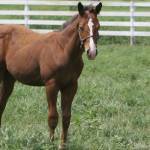Several Factors Affect Birth Weight in Thoroughbred Foals

Everyone wants to take a big yearling to the sales! The industry perception seems to be that big yearlings can be expected to have better racing performance and therefore will sell for higher prices, and in fact, studies conducted by Kentucky Equine Research have confirmed that larger, taller yearlings actually bring higher prices at yearling sales. A related belief is that foals that are large at birth will become large yearlings.
Various studies have shown a significant positive correlation between birth height and mature height, and proved that birth height can be an accurate predictor of mature height. In addition, withers height and hip height of yearlings have been positively correlated with lifetime earnings and winning percentage, and yearling body length and heart girth are positively correlated with winning percentage. Other research has shown positive relationships between placental weight and foal birth weight, and also between age and parity of the mare (how many foals the mare has had) and placental and foal birth weights.
A recent study conducted in Australia investigated the correlation of placental weight to foal birth weight as well as the interrelationships among mare age, parity, foal sex, length of gestation, and weights of placentas and foals at a commercial Thoroughbred breeding farm. Information was collected on 348 foals born during August, September, October, November, and December of 2006 on a large breeding farm in the Hunter Valley of New South Wales, Australia. An experienced attendant supervised each foaling. Foals that died within 48 hours of birth were not included in the study. Foals were allowed to stay with their dams and to nurse freely before weighing, which took place between two and twelve hours after birth. Foal weights were recorded to the nearest kilogram. The placenta, amnion, and umbilical cord were weighed to the nearest half kilogram. Information was recorded for each mare including age, parity, date of last service, foaling date, and length of gestation. Statistical analyses were conducted to determine correlations among sets of data.
Live births on the subject farm totaled 348 (170 colts and 178 fillies), and all were included in the study. Eight foals were stillborn or died shortly after birth and were not included. Mean birth weight was 55.8 kilograms for colts and 54.7 for fillies. Mean placental weight was 6.4 kilograms. Foal sex was not significantly correlated with either birth weight or placental weight. There was a strong positive relationship between placental weight and foal weight up to placental weights of about 6.5 kilograms, after which there was negligible foal weight change with increasing placental weight.
With increasing mare age, foal weight increased about 0.5 kilograms per year and placental weight increased about 0.04 kilograms. For every extra foal produced, foal weight increased about 0.8 kilograms and placental weight increased about 0.06 kilograms. Because mare age and parity were related, further analysis was done to examine the independent correlation between foal weight and mare age. This showed there was no true association between mare age and foal weight when considered aside from parity. Because the largest effect of parity on foal birth weight was between maiden mares’ foals and second parity mares’ foals, parity rather than age may influence foal birth weight and placental weight. The researchers suggested that the equine uterus may need to be “primed” by a first pregnancy before it can allow maximal fetal growth.
Estimated effects of gestation length on weights of foals and placentas were similar after an adjustment was made for mare age and parity. Somewhat surprisingly, longer gestation did not produce significantly larger foals or heavier placentas.
This study demonstrated an important relationship between placental weight and birth weight of foals, but neither mare’s age nor gestation length appeared to have significant effects on placental weight. Because this study looked only at foals on one farm in one year, it eliminated variables such as weather and management practices. On the other hand, results from this study may not hold true for every equine population, as it is possible that studies on other farms in different locations could have varying results.








